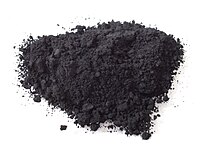
Photo from wikipedia
Abstract Rational design of electrode materials with tunable pore structure and large specific surface area (SSA) are of great importance for boosting high-performance supercapacitors (SCs) and micro-supercapacitors (MSCs). Here we… Click to show full abstract
Abstract Rational design of electrode materials with tunable pore structure and large specific surface area (SSA) are of great importance for boosting high-performance supercapacitors (SCs) and micro-supercapacitors (MSCs). Here we develop a nitrogen doped hierarchically porous carbon aerogel (NPCA) derived from chitosan biomass via a combined chelation reaction and freeze-drying procedures for SCs and MSCs. The NPCA exhibits three-dimensional (3D) reticular texture with ultrahigh SSA of 2529 m2 g−1, which is highly responsible for accommodating large charge storage. The interconnected micro-/mesopores distributed on the continuous carbon network can create more adsorption sites and commodious channels for fast ion diffusion, yet offer high electrical conductivity for rapid electron transport. As a result, the assembled symmetric SC using NPCA exhibits enhanced electrochemical performance with energy density of 6.8 Wh kg−1 at power density of 251 W kg−1. More importantly, the solid-state flexible NPCA-MSC presents high areal capacitance of 25.6 mF cm−2, outstanding energy density of 0.78 μWh cm−2, exceptional cyclability with only 1% capacitance fading after 10000 cycles, and superior flexibility with capacitance retention of 99%. Therefore, this biomass-derived carbon strategy will provide numerous opportunities to develop low-cost 3D micro-/mesoporous heteroatom-doped carbon aerogels for high-performance SCs and MSCs in a large scale.
Journal Title: Carbon
Year Published: 2020
Link to full text (if available)
Share on Social Media: Sign Up to like & get
recommendations!